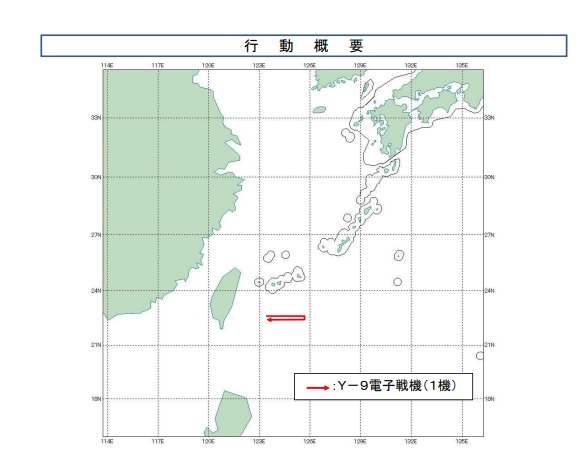On June 8, the Japanese Ministry of Defense (MoD) announced it had for the first time identified a new type of Y-9 intelligence gathering aircraft of the Chinese military approaching Japan’s airspace south of Sakishima Islands in Okinawa prefecture, which is also to the east of Taiwan.
The MoD released an image of the aircraft on June 8. More than a few China military experts have identified the new aircraft as the Shaanxi Aircraft Industry Corporation (SAIC) Y-9DZ aircraft, also known as the Y-8GX-12. The aircraft is China’s newly developed electronic warfare (EW) version of the Y-9 aircraft, succeeding the Y-8 medium transport aircraft.
As the Chinese People’s Liberation Army Air Force (PLAAF)’s state-of-the-art electronic reconnaissance aircraft, the Y-9DZ was first photographed by satellite at the Flight Test and Research Institute (CFTE) in Xi’an in November 2017. It is China’s latest multipurpose electronic warfare aircraft.
Japan’s photograph of the aircraft, from the port side, shows some additional details. Most notably, unlike previous Y-9 variants, on the Y-9DZ a synthetic aperture radar (SAR) antenna is installed underneath the forward fuselage to provide high-resolution ground mapping images.
The aircraft possesses two large rectangular shaped electronic support measures/electronic intelligence (ESM/ELINT) antennas on both sides of its rear fuselage. It also has an oval dish-shaped ESM antenna on top of the vertical fin and a Satellite Communication (SATCOM) antenna on top of the mid-fuselage.
In addition, according to Janes Defence Weekly, the aircraft likely has a weather radar system in the bulbous nose and an unknown type of radar in a rear cone of the aircraft’s fuselage.
These features will make the Y-9DZ more effective in intelligence, surveillance, and reconnaissance (ISR) missions, and suggest the aircraft can perform various special missions such as EW, ELINT, ESM, monitoring the enemy’s movement, electronic jamming, and psychological warfare (PSYOPS).
According to the flight path map released by the MoD, the Y-9DZ circled over the Pacific Ocean on the east side of Taiwan Island through the Bashi Strait between Taiwan and the Philippines on June 8. It then returned by the same route in the direction of the Bashi Channel.

This map, provided by Japan’s Ministry of Defense, shows the flight path of the Y-9DZ on June 8, 2023.
What was the purpose of this flight?
According to the MoD, Japan-U.S.-France joint exercises were conducted east of Okinawa and in the East China Sea from June 7 to 10. A total of 12 warships participated, including the U.S. Navy’s nuclear-powered aircraft carriers Ronald Reagan and Nimitz, and the Japan Maritime Self-Defense Force (JMSDF) helicopter carrier JS Izumo. The Japan Air Self-Defense Force (JASDF) and the U.S. Air Force also joined. Japan, the United States, and France conducted various tactical exercises to promote cooperation with China in mind, as it seeks to unilaterally change the status quo by force or coercion.
In response, the Chinese military sent the Y-9DZ to conduct ISR activities against these joint exercises in the Pacific Ocean to the east of Taiwan. Some experts estimate that there were just 500 kilometers between the Y-9DZ’s flight zone and the area of the Japan-U.S.-France joint exercise.
On June 11, China’s Global Times published an article titled “PLA deploys new-type recon aircraft as US, Japanese carriers hold drills east of Taiwan island.”
“This sea region, located to the east of the island of Taiwan, is of key strategic value in the Taiwan question, because from there, the PLA could surround the island and deny foreign military interference attempts,” the article said, citing an unidentified Chinese military expert.
“External forces should stop provoking China by using the Taiwan question and stirring up tensions in the region,” it added.
Meanwhile, Japan is deploying new electronic warfare units responsible for jamming signals ahead of an attack on the country to the Nansei Islands, which stretch southwest from Kyushu toward Taiwan. The western Pacific, including Okinawa and Taiwan, is increasingly becoming new frontier of security, especially as related to electronic warfare.

































